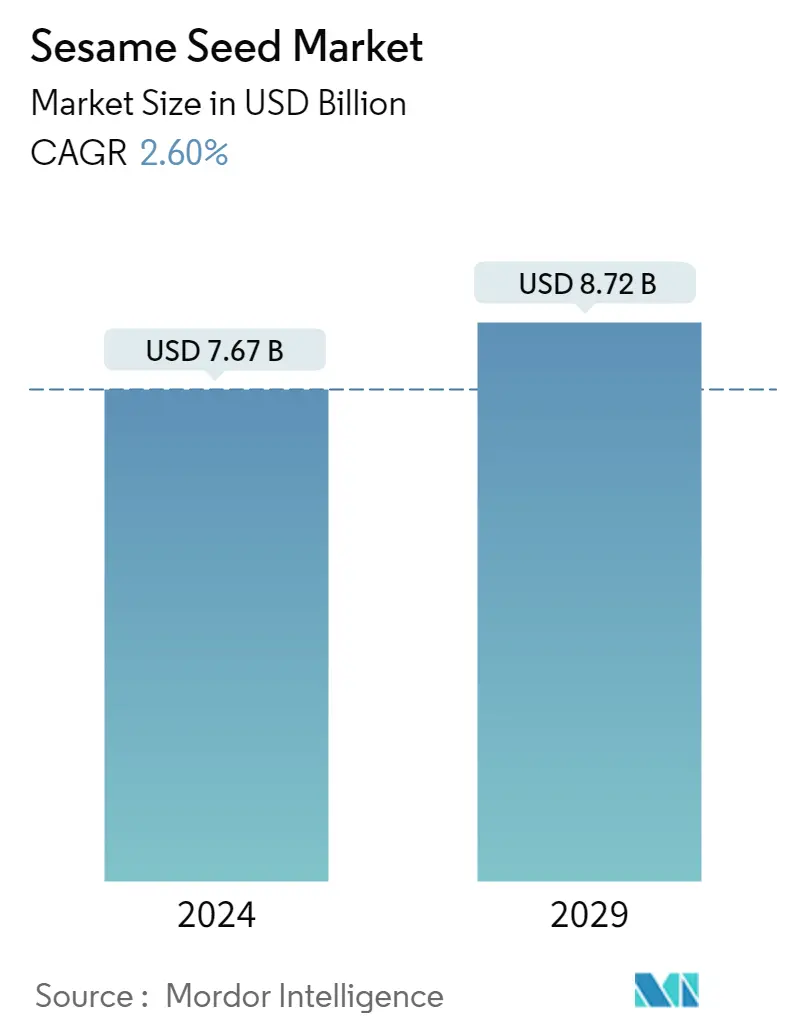Market Size of Sesame Seed Industry

| Study Period | 2019 - 2029 |
| Market Size (2024) | USD 7.67 Billion |
| Market Size (2029) | USD 8.72 Billion |
| CAGR (2024 - 2029) | 2.60 % |
| Fastest Growing Market | North America |
| Largest Market | Asia-Pacific |
Major Players*Disclaimer: Major Players sorted in no particular order |
Sesame Seeds Market Analysis
The Sesame Seed Market size is estimated at USD 7.67 billion in 2024, and is expected to reach USD 8.72 billion by 2029, growing at a CAGR of 2.60% during the forecast period (2024-2029).
The ongoing COVID-19 pandemic compelled consumers to rethink their consumption patterns, leading to the growth in demand for healthy ingredients and creating an opportunity for sesame seeds as ingredients for various food and personal care products. However, the disruptions in trade created a decline in the initial months of 2020. Despite the little disruption, due to the rising consumer inclination toward healthy living and adopting healthy food ingredients, the sesame seed market is anticipated to grow during the forecast period.
Across the world, there is a growing appetite for healthy ingredients in diets among consumers, especially the millennial population across North America and Europe. The nutritional profile of these seeds has gained consumer attraction over the last few years.
The growing demand for superfoods among health-conscious consumers is driving the demand for the market. However, price fluctuations and allergies associated with the commodity are holding back the growth of sesame seeds.
The drivers identified in this market are consumption patterns and increasing health awareness, increasing demand across nations, and advancements and innovations in terms of hybrids. The restraints identified in the market are international price fluctuations, strong international competition, and salmonella risk in sesame seeds.
Sesame Seeds Industry Segmentation
Sesame seeds (Sesamum indicum) are majorly cultivated in tropical and subtropical regions of Asia and Africa. In this report, sesame seed has been considered a commodity and excludes any data with respect to sesame seed for sowing. The Sesame Seeds Market includes the Production Analysis (Volume), Consumption Analysis (Value and Volume), Import Analysis (Value and Volume), Export Analysis (Value and Volume), and Price Trend Analysis. The market is segmented by geography into North America, Europe, Asia-Pacific, South America, and Middle-East and Africa. The report offers the market size and forecasts in terms of volume in metric tons and value in USD thousand for all the above segments.
| Geography (Production Analysis, Consumption Analysis by Value and Volume, Import Analysis by Value and Volume, Export Analysis by Value and Volume, and Price Trend Analysis) | ||||||||
| ||||||||
| ||||||||
| ||||||||
| ||||||||
|
Sesame Seed Market Size Summary
The sesame seed market is poised for steady growth over the forecast period, driven by an increasing consumer shift towards healthy and natural ingredients. The COVID-19 pandemic has accelerated this trend, as consumers have become more health-conscious, seeking out superfoods and functional ingredients like sesame seeds. These seeds are gaining popularity due to their nutritional benefits, including their role in digestion and hypertension reduction, as well as being rich in polyphenols, antioxidants, vitamins, and minerals. The market is experiencing a rise in demand across North America and Europe, particularly among millennials, who are drawn to the seeds' health benefits and versatility in various food and personal care products. Despite challenges such as price fluctuations and potential allergies, the market is supported by advancements in seed hybrids and increasing health awareness.
The sesame seed market is further bolstered by its application in the food and beverage industry, where it is used as a topping, condiment, and ingredient in baked goods and packaged foods. In the United States, the seeds are particularly popular due to their potential health benefits, such as weight reduction, which aligns with the growing demand for healthy dietary options amid rising obesity rates. The seeds' resilience to adverse weather conditions and minimal cultivation requirements make them a favored crop among farmers, contributing to increased production. However, the market faces challenges from international price fluctuations, strong competition, and health risks like salmonella. Despite these challenges, the market's growth trajectory remains positive, driven by consumer preferences for naturally derived, health-based products and the seeds' expanding role in pharmaceutical formulations.
Sesame Seed Market Size - Table of Contents
-
1. MARKET DYNAMICS
-
1.1 Market Overview
-
1.2 Market Drivers
-
1.3 Market Restraints
-
1.4 Value Chain Analysis
-
1.4.1 Value Chain Overview
-
1.4.2 Price Markups in the Value Chain
-
1.4.3 Stakeholders in the Value Chain
-
-
-
2. MARKET SEGMENTATION
-
2.1 Geography (Production Analysis, Consumption Analysis by Value and Volume, Import Analysis by Value and Volume, Export Analysis by Value and Volume, and Price Trend Analysis)
-
2.1.1 North America
-
2.1.1.1 United States
-
2.1.1.2 Canada
-
2.1.1.3 Mexico
-
-
2.1.2 Europe
-
2.1.2.1 Germany
-
2.1.2.2 United Kingdom
-
2.1.2.3 France
-
2.1.2.4 Netherlands
-
2.1.2.5 Spain
-
2.1.2.6 Russia
-
-
2.1.3 Asia-Pacific
-
2.1.3.1 China
-
2.1.3.2 Australia
-
2.1.3.3 India
-
2.1.3.4 Japan
-
-
2.1.4 South America
-
2.1.4.1 Brazil
-
2.1.4.2 Argentina
-
-
2.1.5 Middle-East and Africa
-
2.1.5.1 South Africa
-
2.1.5.2 Tanzania
-
2.1.5.3 Sudan
-
2.1.5.4 United Arab Emirates
-
-
-
Sesame Seed Market Size FAQs
How big is the Sesame Seed Market?
The Sesame Seed Market size is expected to reach USD 7.67 billion in 2024 and grow at a CAGR of 2.60% to reach USD 8.72 billion by 2029.
What is the current Sesame Seed Market size?
In 2024, the Sesame Seed Market size is expected to reach USD 7.67 billion.

